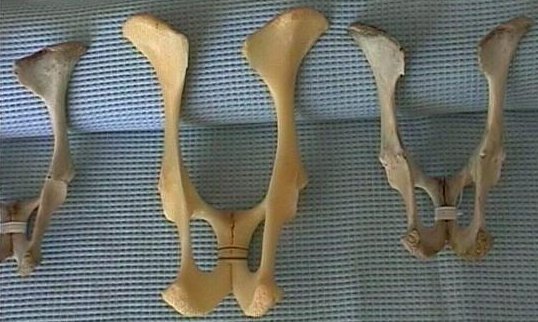|
Figure 5 The 10-month old twins’ bones are dark because they were not bleached. Notice the as yet incomplete fusion of the two major bones that attach at the acetabulum. Their cartilaginous center joint (pubic symphysis) had not yet fused, so the halves are wired together. While the doe's pelvis (left) is not shown completely, you can see that her bone is thinner than her brother's (right) and her pelvic opening is larger. This is normal. The major bones of wether (center) had fused at the acetabulum but his pubic symphysis had not. Fusion of joints like these is influenced by male/female hormones, and in wethers this process is delayed. That is why wethers grow larger than they would have as bucks - their bone maturation is delayed. |

I apologize for the incompeteness of this image. The bones are inacessible for better photography due to a home remodeling project. When I locate them I will take a better picture. |
| Again, each half of the pelvis consists of three bones. The ileum (long bone) attaches the pelvis to the rest of the body at the sacroiliac articulations - this forms the hips..The ileum and ischium join to form the acetabulum (thigh joint). The pin bone is at the lower end of the ischium. The pubis is the small center bone which fuses with its mate at the pubic symphysis (center), a joint that is cartilage at birth and hardens by maturity. | |